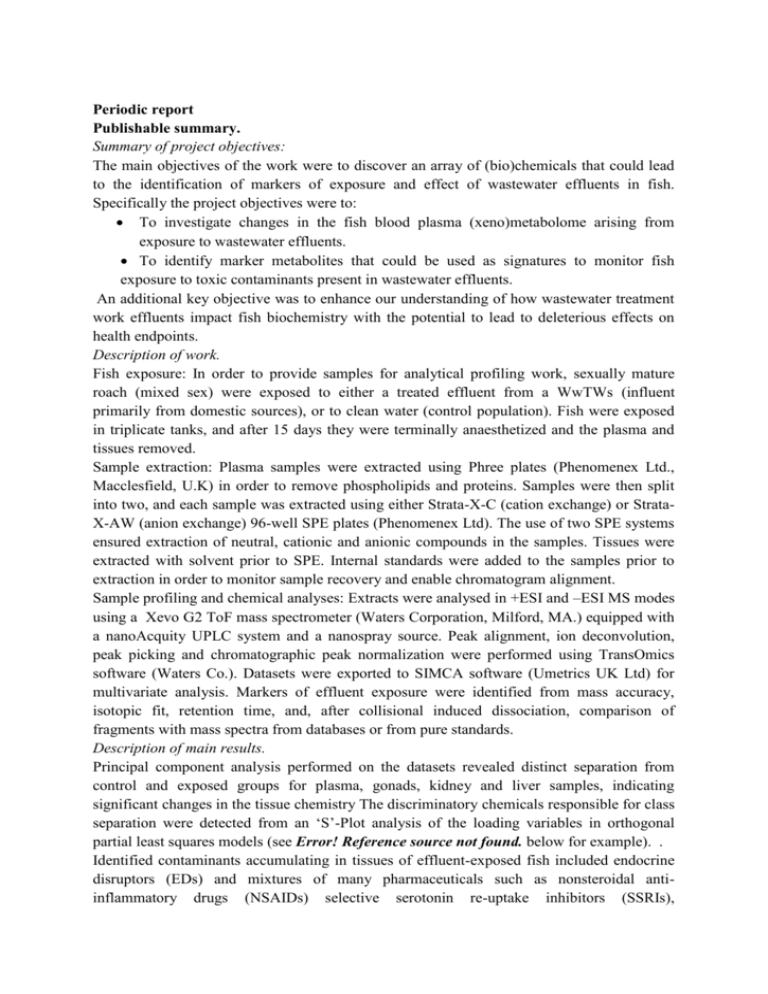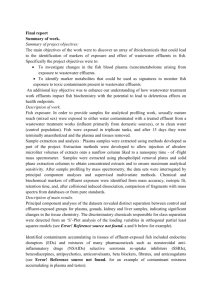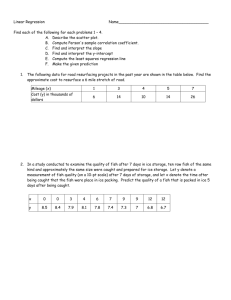periodic1-ad-mc-periodic-report-july-25th-2014
advertisement

Periodic report Publishable summary. Summary of project objectives: The main objectives of the work were to discover an array of (bio)chemicals that could lead to the identification of markers of exposure and effect of wastewater effluents in fish. Specifically the project objectives were to: To investigate changes in the fish blood plasma (xeno)metabolome arising from exposure to wastewater effluents. To identify marker metabolites that could be used as signatures to monitor fish exposure to toxic contaminants present in wastewater effluents. An additional key objective was to enhance our understanding of how wastewater treatment work effluents impact fish biochemistry with the potential to lead to deleterious effects on health endpoints. Description of work. Fish exposure: In order to provide samples for analytical profiling work, sexually mature roach (mixed sex) were exposed to either a treated effluent from a WwTWs (influent primarily from domestic sources), or to clean water (control population). Fish were exposed in triplicate tanks, and after 15 days they were terminally anaesthetized and the plasma and tissues removed. Sample extraction: Plasma samples were extracted using Phree plates (Phenomenex Ltd., Macclesfield, U.K) in order to remove phospholipids and proteins. Samples were then split into two, and each sample was extracted using either Strata-X-C (cation exchange) or StrataX-AW (anion exchange) 96-well SPE plates (Phenomenex Ltd). The use of two SPE systems ensured extraction of neutral, cationic and anionic compounds in the samples. Tissues were extracted with solvent prior to SPE. Internal standards were added to the samples prior to extraction in order to monitor sample recovery and enable chromatogram alignment. Sample profiling and chemical analyses: Extracts were analysed in +ESI and –ESI MS modes using a Xevo G2 ToF mass spectrometer (Waters Corporation, Milford, MA.) equipped with a nanoAcquity UPLC system and a nanospray source. Peak alignment, ion deconvolution, peak picking and chromatographic peak normalization were performed using TransOmics software (Waters Co.). Datasets were exported to SIMCA software (Umetrics UK Ltd) for multivariate analysis. Markers of effluent exposure were identified from mass accuracy, isotopic fit, retention time, and, after collisional induced dissociation, comparison of fragments with mass spectra from databases or from pure standards. Description of main results. Principal component analysis performed on the datasets revealed distinct separation from control and exposed groups for plasma, gonads, kidney and liver samples, indicating significant changes in the tissue chemistry The discriminatory chemicals responsible for class separation were detected from an ‘S’-Plot analysis of the loading variables in orthogonal partial least squares models (see Error! Reference source not found. below for example). . Identified contaminants accumulating in tissues of effluent-exposed fish included endocrine disruptors (EDs) and mixtures of many pharmaceuticals such as nonsteroidal antiinflammatory drugs (NSAIDs) selective serotonin re-uptake inhibitors (SSRIs), benzodiazepines, antipsychotics, anticonvulsants, beta blockers, fibrates, and anticoagulants (see Error! Reference source not found. for an example of contaminant mixtures accumulating in plasma and testes). Metabolite profiling revealed disturbances in eicosanoid, steroid, serotonin, bile acid, carnitine and sphingosine pathways. Some of these metabolite disruptions can be linked to the presence of types of key chemical stressors in the tissues. For instance, NSAIDs inhibit cyclooxygenase activity and consequently prostaglandin (PG) synthesis; SSRIs modulate the serotonin pathway and EDs can disrupt androgen biosynthesis. Metabolite disruption was apparent although the plasma concentrations of these contaminants were 3-1000 fold below human therapeutic levels indicating possible mixture effects. SSRIs, NSAIDs, and EDs were all detected in the testes, and these classes of compounds are reported to cause endocrine disrupting effects associated with the reproductive axis. This work revealed that using sensitive nontargeted chemical profiling techniques enable detection of contaminant mixtures and disruption of key metabolite pathways in fish tissues. Effluent exposure resulted in disturbance of a number of fundamental signalling pathways in fish; these include widespread reduction of prostaglandins in many tissues and these mediators are important in ion transport, immune function and reproduction. In addition, reduction in androgen and increases in serotonin metabolites were observed, indicating potential effects on reproductive and neurological endpoints. This nontargeted approach could be extremely informative for ecotoxicological investigations on the health effects and associated contaminant mixtures in fish exposed to wastewater effluents. Socio-economic impact and implications This work provides the tools and techniques needed to investigate the impact of contaminated environments on aquatic organisms. It has resulted in findings that indicate the fish in effluent contaminated waters are highly vulnerable to exposure to a number of pharmaceuticals affecting behavioural, immune and reproductive function. The work directly contributes knowledge important for the risk assessment of contaminants in the aquatic environment and is relevant to EU policy and legislation particularly in respect to the Water Framework Directive. Training activities. A number of training activities were completed as follows: Training at the University of Sussex included training in nanoflow/nanospray mass spectrometry, and in multivariate analyses. Courses in Handling Pressure- a positive approach, Vocal vitality- effective vocal skills and voice care, Publication without Pain workshop, workshops on improving producing grant applications to EU and research councils. I also attended workshops on bioinformatics and metabolomics at a Technology Training Workshop in Cardiff, UK organised as part of the NERC Environmental ‘Omics Synthesis conference in September 2013. Figures and Tables. a) Quality Control (n=7) Female Control (n=13) Male Control (n=10) Female Exposed (n=16) b) Metabolites/chemicals increased by effluent exposure Male Exposed (n=11) Metabolites decreased by effluent exposure Figure 1: Principal component analysis (a) and ‘S’ scatter plot analysis (b) of the chemical profiles in plasma of roach exposed either to treated WwTW effluent or control water. The samples were profiled in −ESI mode by nUPLC-nESI-TOFMS. Quality control samples were used to monitor the analytical performance of the MS. In the scores plot in a) clear separation was observed between the blood samples from fish exposed to effluent contaminated water compared with fish exposed to clean water. In b) the data from a) was further interrogated to detect the chemical contaminants taken up by fish and also any changes in metabolite profiles as a result of chemical exposure. Table 1: Chemical contaminants detected in effluent-exposed fish and disruption of metabolite concentrations. Class of chemicals exposed fish detected in Concentrations Plasma Testes (ng/ml) (ng/g) NSAIDs (diclofenac, ibuprofen, naproxen, 0.5 mefenamic acid) 43.6 SSRIs (fluoxetine, paroxetine, sertraline, citalopram, venlafaxine) norfluoxetine, 2.1 norsertraline, 2.3 EDs (bisphenol A, triclosan, chlorophene, 2.1 propiconazole) 4.5 Other xenobiotics (nordiazepam, clozapine, norclozapine, quetiapine, norquetiapine, 0.5 warfarin, carbamazepine, propranolol, 1.3 gemfibrozil, clopidogrel - - - - Metabolite disruption detected in plasma/testes of effluent-exposed fish 3 fold decrease in 0.1 prostaglandin E2 levels 5.2 (p<0.01) 5 fold increase in serotonin metabolite levels 0.7- 2.7 e.g. 5-methoxy-tryptophan (p<0.01) 2 fold decrease in 0.2 androstenedione levels 13.4 (p<0.05) Other affected pathways: 0.13 - 2-10 fold increases in bile 2.7 acids, carnitines, and sphinganines










